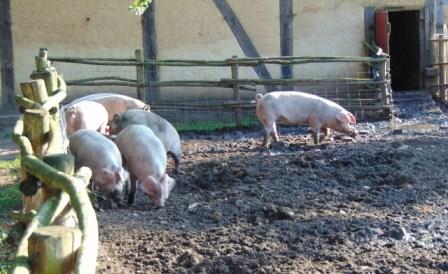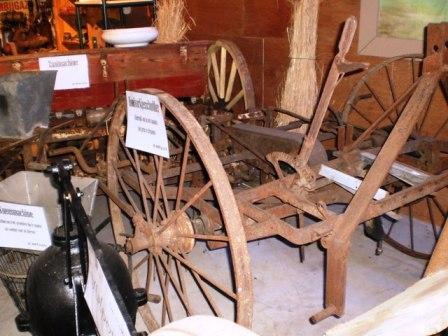Besides forestry, fishing and livestock we also apply tillage to soils to harvest crops as food.
With (among others) grassland we produce food for livestock.
Agriculture (or farming) includes not only arable crops (field culture) also horticulture.
Agriculture evolved from mixed farming to feed the farmer and his family into economic production and income.
 Our ancestors took an important step when they realized they could grow edible plants and seeds themselves that they had to gather before. There was therefore more food available, closer and without searching. Rambling was no longer necessary. Housing improved consequently.
Our ancestors took an important step when they realized they could grow edible plants and seeds themselves that they had to gather before. There was therefore more food available, closer and without searching. Rambling was no longer necessary. Housing improved consequently.
Through selection also improved the quality of seeds and fruits.
Nowadays, we can even genetic manipulate.
Agriculture and horticulture is still the foundation to provide one of our primary needs, and to be able to survive.
Everyone used to have its own garden, pasture and field, and crafting and harvesting was a part of a natural cycle. Today we are probably too many people, and we must do it with less surface area. Crops growing became therefore also more intense and almost industrial.
The distance between the farmer and the consumer has become very large, both in kilometers and in engagement.
Fortunately, there is an increasing interest in healthy and natural food, which is won in harmony with our environment.
In our region we have a good climate and good soil.
We should have to deal with it caring.
 Amongst others, the Handbook of Organic Gardening (VELT, Berchem) contains lots of good info.
Amongst others, the Handbook of Organic Gardening (VELT, Berchem) contains lots of good info.
Energy containing crops for self reliant visionaries
Some highlights: nuts (walnuts, almonds ...), linseed, sunflower seeds, sesame, egg, liver.
The better food crops for self-sustaining have a good yield and caloric value to extract the carbohydrates for your daily energy. And they must be easy to harvest and store. Amongst them potatoes (harvest in 65 to 90 days), corn, beans, squash.
Kale is one of the most nutrient-rich vegetables with a lot of vitamins and minerals. Broccoli too.
Berries are low in sugar and rich in vitamins, minerals and antioxidants. Especially blackberries and black currants are super healthy.
Also, organic spirulina (algae) contain many antioxidants, proteins and minerals. Tasty in a smoothie.
A publication from FAO (Food and Agriculture Organization of the United Nations) states: "There are 10,000 plants that we can eat. Only 150 of these are used. 85 percent of the world's consumption consists of rice, wheat, maize and potatoes. The latter comes under 'staple foods' (mass consumed, energy-rich food), which certainly needs supplementation and variation. These crops are mainly grains, tubers and roots. In order of worldwide volume: Maize / Corn (Central America and Mexico), wheat (Middle East), rice (China), potatoes (and quinoa: Andes), cassava, soy beans, sweet potatoes, Sorghum, yams, plantains.
Since 2020, it has been believed that the Llanos de Moxos region (south-west Amazon) was a fifth key region with me manioc (cassava, yuca) since 10,350 years ago. With 100 years later pumpkin / squach (and corn only 6,850 years ago).
The Celtic Fields (or comb fields) were built on arable land already used before. Large scars of processing in the soil structure were found under the ramparts. The first agriculture just happened on bald strips and spots. Around 700 BC. farmers began to remove stones and tree stumps from the fields and throw them on the side of the plots.
The fields were job friendly with a meter or forty by forty top plow. They could be edited in one day with an ard (wheel-less plough). In order to keep the fields fertile, new sods from elsewhere were occasionally thrown on. The old top layer was then dumped on the ramparts, which became wider and firmer. The proof: calculations showed that there was much more material on the ramparts than the maximum that could be removed of the fields .
Many Celtic Fields disappeared, entrained in the fall of the Western Roman Empire.
Already 7,000 years ago, agriculture in Flanders was introduced from the east via Germany and the Netherlands. Farmers sought the fertile loam soils, especially in Limburg. At the same time there were hunter-gatherers here. Band ceramics settled in clusters of settlements. Sometimes only a few hundred meters apart. There are traces of economic exchange between those cultures. So there was peaceful contact. Very typical for the villages are the up to 30 m long residential houses.
Concerning archaeological zone are the Winkelveld in Hoeselt, the Flikkenberg in Rosmeer (Bilzen), the Keiberg near Vlijtingen (Riemst), the Sieberg near Herderen (Riemst), the Bosberg near Rosmeer (Bilzen) and the Staberg near Rosmeer (Bilzen)
Remnants of the oldest Flemish farm were excavated in Riemst. The dwelling of about 25 by 6.5 meters was built around 5,200 BC. by people from the band ceramic culture. In the bottom are a few pieces of pottery and flint tools found.
Also in Rosmeer and Maastricht are such farms discovered with a northwest part, as an (extra) accommodation or housing, a middle space as living and working space, and the southeast as storage.
